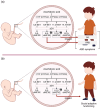Arachidonic acid-derived dihydroxy fatty acids in neonatal cord blood relate symptoms of autism spectrum disorders and social adaptive functioning: Hamamatsu Birth Cohort for Mothers and Children (HBC Study)
- PMID: 39041066
- PMCID: PMC11488600
- DOI: 10.1111/pcn.13710
Arachidonic acid-derived dihydroxy fatty acids in neonatal cord blood relate symptoms of autism spectrum disorders and social adaptive functioning: Hamamatsu Birth Cohort for Mothers and Children (HBC Study)
Abstract
Aim: Autism spectrum disorder (ASD) is associated with abnormal lipid metabolism, such as a high total ratio of omega-6 to omega-3 in polyunsaturated fatty acids (PUFAs). PUFAs are metabolized to epoxy fatty acids by cytochrome P450 (CYP); then, dihydroxy fatty acid is produced by soluble epoxide hydrolase. This study examined the association between PUFA metabolites in the cord blood and ASD symptoms and adaptive functioning in children.
Methods: This prospective cohort study utilized cord blood to quantify PUFA metabolites of the CYP pathway. The Autism Diagnostic Observation Schedule (ADOS-2) and Vineland Adaptive Behaviors Scales, Second Edition (VABS-II) were used to assess subsequent ASD symptoms and adaptive functioning in children at 6 years. The analysis included 200 children and their mothers.
Results: Arachidonic acid-derived diols, 11,12-diHETrE was found to impact ASD symptom severity on the ADOS-2-calibrated severity scores and impairment in the socialization domain as assessed by the VABS-II (P = 0.0003; P = 0.004, respectively). High levels of 11,12-diHETrE impact social affect in ASD symptoms (P = 0.002), while low levels of 8,9-diHETrE impact repetitive/restrictive behavior (P = 0.003). Notably, there was specificity in the association between diHETrE and ASD symptoms, especially in girls.
Conclusion: These findings suggest that the dynamics of diHETrE during the fetal period is important in the developmental trajectory of children after birth. Given that the role of diol metabolites in neurodevelopment in vivo is completely uncharacterized, the results of this study provide important insight into the role of diHETrE and ASD pathophysiology.
Keywords: adaptive functioning; arachidonic acid; autism; cord blood; dihydroxy eicosatetraenoic acid.
© 2024 The Author(s). Psychiatry and Clinical Neurosciences published by John Wiley & Sons Australia, Ltd on behalf of Japanese Society of Psychiatry and Neurology.
Figures


References
-
- Lee AS, Azmitia EC, Whitaker‐Azmitia PM. Developmental microglial priming in postmortem autism spectrum disorder temporal cortex. Brain Behav. Immun. 2017; 62: 193–202. - PubMed
MeSH terms
Substances
Grants and funding
LinkOut - more resources
Full Text Sources
Medical

